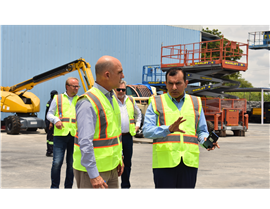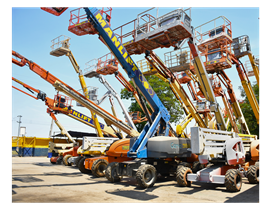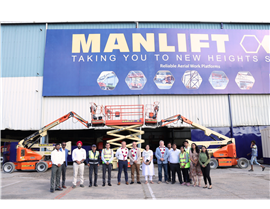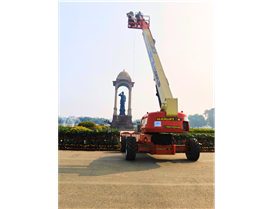Interview: Is India the next major access market?
14 February 2024
AI delves into the Indian market, which has been touted as the next ‘China’ in terms of growth. Find out the viewpoint of Pedro Torres, CEO of Riwal Holding Group, and Munish Taneja, country manager for the Riwal’s Manlift brand.
India is on the cusp of major MEWP growth, now that the economy is on the up and there are major strides being made in infrastructure and global construction companies are investing heavily.
 In the forefront: Pedro Torres & Munish Taneja, at the Manlift depot in Great Noida.
In the forefront: Pedro Torres & Munish Taneja, at the Manlift depot in Great Noida.
The stable political system, complemented by a 7.2% rise in GDP in 2023, the largest globally, has helped establish the base on which to kick start the aerial platform market; that being the acceptance of powered access as a cost-effective alternative over traditional means, along with other crucial factors like a rise in the cost of labour and increased acceptance of safety on worksites.
The estimated number of platforms operational in India is around 14,000 units, which reflects a year-on-year growth of 25% in the last two years. Leading the way in the Indian access rental sector is Manlift, which has 10% share of the country’s total rental fleet, according to Pedro Torres, CEO of Riwal Holding Group, and Munish Taneja, Country Manager for the Manlift brand in India.
Rental dynamics
Riwal is called Manlift in the UAE, Qatar and India and with the brand having been established 15 years ago, there was an expectation that large scale growth of India’s MEWP market would have come sooner, but the complex political and economic circumstances have meant that true potential for MEWPs is now just ready to be reached.
Taneja says, “Rental penetration in India is still very low. It has been growing in the past couple of years but it is nowhere near as mature as the construction equipment market. But, now we see that this is the time for us to prepare for the growth, and it’s about to take off to the next level.”
 Part of the Manlift India fleet.
Part of the Manlift India fleet.
As Torres adds, Manlift benefits from the company’s experience in the European markets, and employs rental management initiatives like the Manlift Way – the best practice ethos of the company, an international ERP system, sustainability policies, and the My Manlift app. According to Torres, Manlift has the added advantage of that it arrived so early in the Indian MEWP market that in many areas of the country aerial platforms are known as Manlifts, rather than any of the global generic terms like AWP or aerial platform.
However, these kind of emerging market quirks are set to end in India as its MEWP market takes off and the levels of competition among OEMs targeting the country increases. Torres forecasts that in five years’ time the MEWP population may have reached 40,000-50,000.
Manlift currently has three depots; the principle office in the North, Greater Noida, Uttar Pradesh, a second in the West of the country, Sanand, Gujarat, and another in the South, Penukonda, Andhra Pradesh. With exponential growth forecasted over the coming years, Manlift is set to introduce two or three depots to help cover India’s vast geography.
Torres adds, “We had been expecting the market to grow faster, but if you see the pipeline of projects, the economical country plans and the trajectory in terms of GDP, the country is expecting to be the third largest economy in the world ahead of Germany and Japan and behind the US and China by 2030.”
Huge potential
Although Torres and Taneja forecast that the five-year growth rate in India won’t be as fast paced as that found in China, which saw its MEWP population rise from around 40,0000 units in 2017 to approaching 500,000 units five years later in 2022.
Taneja says, “There is a huge potential. In the last two years we have done a lot of work in educating customers and the awareness is getting to an advanced level where customers understand the benefits, productivity, safety standards and efficiency at work sites.
 The Manlift India HQ team: David King, Regional Director for Manlift Countries; Munish Taneja, Country Manager Manlift India; Mansi Gujrati, Finance Manager Manlift India; Roshan Alberts, Regional Finance Controller Manlift. Riwal Group: Pedro Torres, CEO; and René Timmers, CFO.
The Manlift India HQ team: David King, Regional Director for Manlift Countries; Munish Taneja, Country Manager Manlift India; Mansi Gujrati, Finance Manager Manlift India; Roshan Alberts, Regional Finance Controller Manlift. Riwal Group: Pedro Torres, CEO; and René Timmers, CFO.
“But this awareness is not everywhere. When you look at India, which has 28 states, the major economic activity is in the west and south of India and that’s where we see higher penetration levels, compared to the east or some parts of the north.”
One of the major issues is that all aerial platforms in India are supplied with an operator. Torres says, “They think that if a machine does not have an operator, then they cannot use the machine.
“That means if a rental company grows quickly, it may have to employ potentially thousands more operators. This is a barrier to wide MEWP expansion in the country.
“The challenge remains to persuade users that they can easily be trained to operate the equipment.”
The custom of supplying an operator with every machine also creates inefficient work practice as two people are always required in the basket.
And, there is another reason why growth in India is not expected to be as fast as in China – the lack of domestic manufacturers.
“We do not have any major manufacturers based here. The equipment is being imported from Europe, North America and China and that adds to the price, with shipping costs and custom duties.”
Future manufacturing
This situation is set to change, however. JCB has recently set up in the country and there is word that other major MEWP manufacturers in the west are planning to do the same with factories reported to open in the country this year.
“As more and more manufacturers come to India, prices will become more competitive and the delivery times will be better.
“[Whereas at the moment], we see more and more companies using scaffolding, as they compare the cost, and it is much lower. This would change massively if more new equipment was easily available.”
Apart from major international OEMs looking seriously at setting up in India, there are several existing companies in India that are in the advanced stages of product development, and Torres and Taneja believe there will be five to six Indian manufacturers in the next three years.
In the meantime, the traditional manufacturers from North America and Europe are well established in the market. “JLG and Genie are well known brands, having first mover advantage, and in the last couple of years we are seeing Chinese manufacturers being more aggressive in terms of their offerings,” says Taneja.
As of today, Taneja believes the China-based OEMs already have about 50% share of new machine sales in the country.
Would Manlift consider buying equipment from those Chinese suppliers? Torres answers, “We will continue working with our main supplier JLG and that is our strategy, as it is in Europe, but we are open to other manufacturers because we can also import directly from China.”
As with many emerging markets, the boom lift is the most prevalent equipment type in India. Taneja comments, “The scissor market is very competitive. With India being such a large country, operating scissor lifts in these geographies can be challenging.
“With Manlift having a pan-India presence, we favour boom lifts, although we do offer scissors as a complete solution.”
In numbers, this amounts to 40% of Manlift’s fleet being scissors, while boom lifts make up the rest.
Torres adds, “There are more boom lifts in rental in India. That is what is being demanded and that is what we follow, but that will change in the next years to become more like Europe.”
Emission awareness
 A JLG 1200SJP onsite.
A JLG 1200SJP onsite.
When it comes to which type of new boom lifts Indian companies are ordering, diesel is still the power option of choice, with all electric RT equipment not yet on many rental outfit’s radar.
Taneja says, “Electric scissors are more advanced, 60% of this equipment is electric, but for boom lifts it is 8-10%. The awareness of electric machines and the importance of sustainability goals are not as developed as in mature markets.
“But this awareness is growing, and they are starting to understand the cost savings in fuel consumption and lowering CO2”.
The number of rental companies in the country is also growing, but the majority of them are ‘unorganised’ entities. “Among the organised companies, there are maybe five to eight, which are good around operations and safety.
“But the larger section is made up of unorganised companies - new entrants over the last two years which are testing the market with a few machines - there are maybe 100-200 of these,” says Taneja.
Rental rates are historically low, which makes investment in new equipment less attractive.
Therefore, importing used equipment has been the practice. But again that is changing. “As the market is growing we are seeing rental rates improving, but not at the level we would like - we see there is a scope in the next two years that people will be able to afford to invest in new machines. That is why some are evaluating Chinese equipment which is substantially cheaper.”
Multi-national attention
Besides these rental maturity factors, Taneja points out that multi-national companies are now seeing India as a “sweet spot” for investment.
“Then there are the growing sectors like infrastructure, airports, metro and high-speed rail, which are areas that are doing very well. And, to have better productivity, these contractors are looking at aerial platforms.”
With all this comes a growing middle class and an increasing cost in labour.
Torres adds, “We are seeing there is a shortage of skilled manpower, so we are focusing on training our customers to be operators, to international standards.
“We are always talking to our customers about best practice so that they understand that if they use their own teams as operators, they will be more productive.”
There are no current regulations for standards related to aerial platforms. Taneja reports, “as a responsible company we are promoting IPAF standards. We have a training facility and instructors, and we are training our own operators as well as those from other rental companies.”
Torres adds, “We have a lot of work to do between us, IPAF and the Rental Association of India. We trained 600 operators last year but that is not enough. We need to push to connect with other rental organisations to promote safety in the country and that will the change the way we work at height but there is a long way to go.”
On a positive note, Taneja adds, “More and more international companies are coming to India to manufacturer or introduce facilities and they are bringing safety standards.”
And as Torress reiterates, the future is bright. “If everything goes well we should invest at least €30 million in fleet in the next five years, and if we can do more we will.
STAY CONNECTED



Receive the information you need when you need it through our world-leading magazines, newsletters and daily briefings.
CONNECT WITH THE TEAM









